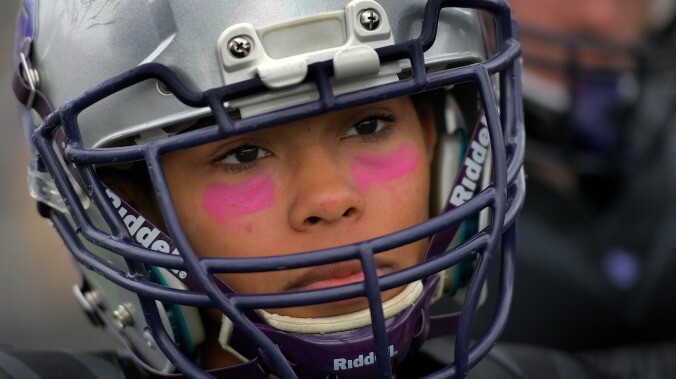They weren’t all kickers: Tackling the history of women in football

This week’s entry: List of female American football players
What it’s about: Are you ready for some football? If so, you’re ready for one of the only sports played almost exclusively by men. But as with most things, there are exceptions, as girls and women have and do play football at every level, from boys’ teams in high school to women’s professional leagues.
Biggest controversy: It’s taken a long time for women to get into the game. While Wikipedia cites estimates of over 1,900 girls playing high school football in 2016, 2,500 playing Pop Warner football, and possibly tens of thousands in youth leagues across America, a long time passed between high school kicker Luverne Wise becoming the first woman to score points in an American football game in 1939, and the sport’s often grudging acceptance of female athletes widening. It would be another 32 years after Wise until high school football saw its first female varsity player in 1972, kicker Theresa Dion, and it wasn’t until 1989 that offensive/defensive tackle Kathleen Trumbo became the first girl to earn a varsity letter for football (she may also be the first female non-kicker to play on a varsity team; she’s the first one Wikipedia lists).
College football was even slower to accept women, as it wasn’t until 1997 that kicker Liz Heaston became the first woman to play college football. Three years later, punter KaLena “Beanie” Barnes became the first female football player in Division I sports. Women were still few and far between—and only kickers—until Shelby Osborne played cornerback at Campbellsville University in 2014.
Strangest fact: There’s a bigger overlap than you’d expect in the football player/homecoming queen Venn diagram. Back in 1981, Oregon high schooler Tami Maida played JV quarterback and was crowned homecoming princess (Helen Hunt played her in the made-for-TV movie, Quarterback Princess, about her career). Cary-Grove, Illinois Trojans kicker Tonya Fletcher was crowned homecoming queen in uniform in 1999; South Iredell, North Carolina’s Julia Knapp made the all-county team as a kicker in 2017; and last year Kaylee Foster was crowned homecoming queen and kicked the game-winning extra point at the homecoming game. (Sadly, Wikipedia neglects linebacker Alicia Woollcott, running back Mimi Britt, and offensive guard/defensive tackle Jenn Benton, who all played more physically demanding positions and were voted homecoming queens at their respective high schools.)
Thing we were happiest to learn: “Your mother was a linebacker” isn’t the insult it sounds like. Barbara Patton played LB for the Los Angeles Dandelions in a semi-pro league in the mid-’70s; her son Marvcus went on to play 13 NFL seasons with Buffalo, Washington, and Kansas City. Only three other ’70s players are mentioned by name here—running backs Carole Duffy and Linda Jefferson, and wide receiver Rae Hodge.
Thing we were unhappiest to learn: Wikipedia’s women’s professional and semi-pro football coverage is spotty at best. There are three women’s leagues currently operating. The Women’s Football Alliance is a sprawling 62-team league with a Division I/II/III setup like college sports. The U.S. Women’s Football League has nine teams (in 2014 they jettisoned a division of teams that played eight on eight instead of the usual 11 players a side), but only the past champions get links (and not the three-time reigning champs, the Washington Prodigy). The Women’s National Football Conference has 20 teams, only five of which have Wikipedia pages. How no one wanted to write about a team with a name like 2020 expansion franchise La Muerte de Las Cruces, or the now-defunct New Orleans Hippies is beyond us. The WNFC formed in 2018, rescuing several franchises from the now-defunct Independent Women’s Football League, whose Wikipedia page has not been updated to reflect the league folding.
Also noteworthy: One of the best-known female football players is one of the youngest. Samantha Gordon joined a previously all-boy youth football league at age 9, and ended up dominating. In her first season, she rushed for 1,911 yards and scored 25 touchdowns, while also making 65 tackles on defense, often against boys twice her size. A highlight reel her dad posted to YouTube went viral, and within a few months she was a national celebrity, garnering praise from the likes of Olympic soccer gold medalist Mia Hamm and Super Bowl MVP Desmond Howard, appearing on a Wheaties box, and being invited to the 2013 Super Bowl by the NFL. In 2015, she helped launch the first all-girl tackle football league in the country in her native Utah.
Further down the Wormhole: Several women have also owned or co-owned professional football teams, but only one co-owned an entire league. Pro wrestling magnate-turned-Trump-political-appointee Linda McMahon co-owned the XFL, a failed one-year men’s league that tried to substitute the WWE’s panache for the NFL’s star power, talent, and basic organizational competence. It turned out that football fans weren’t ready for “kayfabe,” a wrestling term for staged rivalries and conflicts being presented as real. Kayfabe can also apply to fictions like presenting two unrelated wrestlers as brothers, usually in service of a tag team. The concept was stretched to its limits in the case of the Dudley Brothers, an Extreme Championship Wrestling combo from the late ’90s, who professed to be brothers despite shifting membership and differences in appearance (one brother was Black, one was Native American, and the rest were white). One of the original members, Snot Dudley, got his name for picking his nose during matches. We’ll look at nose-picking, that universally shunned (and universally practiced) bad habit next week.